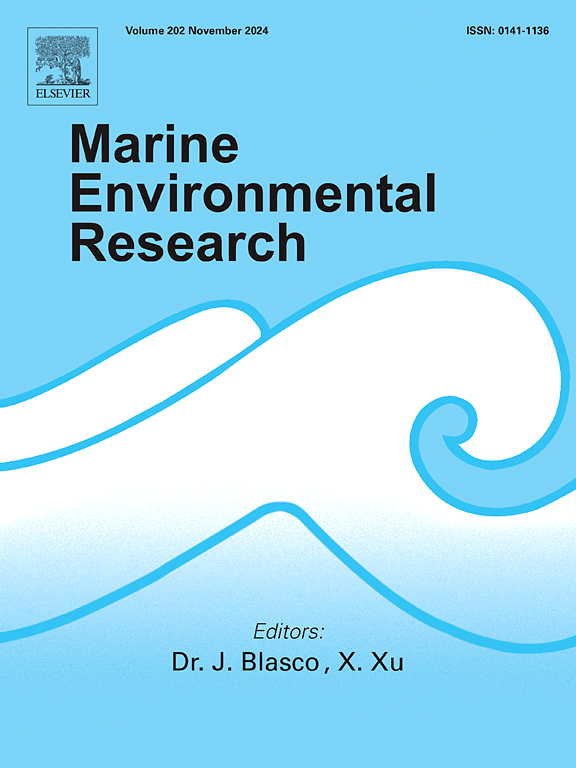利用多元分析方法确定鄂霍次克南部冬季海冰覆盖海域和春季开放水域浮游植物优势组合及其控制因素
IF 3
3区 环境科学与生态学
Q2 ENVIRONMENTAL SCIENCES
引用次数: 0
摘要
鄂霍次克海南部是北太平洋的半封闭边缘海。冬季海冰强烈影响南中国海的物理、生物地球化学和生态系统过程。然而,浮游植物群落从冬季到春季的演替及其与控制因子的关系尚不清楚。在此,我们利用显微镜、藻类色素特征和基于18S rRNA基因(rDNA)的元条形码技术,鉴定了2022年冬季至春季南海浮游植物的优势组合,并将这些数据与环境因素进行了比较。结果表明,尽管根据色素特征估计约有一半的冬季浮游植物是其他浮游植物类群,但硅藻始终是SSO中的优势类群。在冬季,硅藻群落与冰雪覆盖地区的存在有关。利用18S rDNA序列进行共现网络分析表明,中心硅藻海硅藻和毛囊硅藻在冬季与海冰融化的沿海水域有较高的共现关系,有助于叶绿素a较高的春季水华。冰下海水中以Porosira、Bacterosira和Fragilariopsis为代表的冰或冰相关硅藻更有可能影响沿海海水中的藻类组合。我们发现,在受东库页流(ECS)影响的沿海水域,不仅是海冰硅藻,还有冬季浮游植物,都可能导致研究区域出现大规模的春季水华,而且由于气候变暖,海冰减少的情况下,这种现象可能更为普遍。本研究结果强调了综合方法对全面了解浮游植物群落及其在变化环境中的生态特性的重要性。本文章由计算机程序翻译,如有差异,请以英文原文为准。
Determining dominant phytoplankton assemblages and their controlling factors in the winter sea-ice-covered southern sea of okhotsk and the spring open water through a multiple analytical approach
The southern Sea of Okhotsk (SSO) is a semi-enclosed marginal sea of the North Pacific. Winter sea ice strongly influences the physical, biogeochemical, and ecosystem processes in the SSO. However, the succession of phytoplankton assemblages from winter to spring and their relationships with controlling factors remain unclear. Here, we used microscopy, algal pigment signatures, and 18S rRNA gene (rDNA)-based metabarcoding to identify predominant phytoplankton assemblages in the SSO from winter to spring during 2022 and compared these data with environmental factors. As a result, diatoms were the consistently dominant group in the SSO, although about half of the winter phytoplankton were other phytoplankton groups as estimated by pigment signatures. In winter, diatom communities were associated with the presence of ice-covered regions. Co-occurrence network analysis using 18S rDNA sequences showed that the centric diatoms Thalassiosira and Chaetoceros had higher co-occurrence relationships with ice-melted coastal waters in winter, contributing to the spring bloom with higher chlorophyll a. The ice or ice-related diatoms represented by Porosira, Bacterosira, and Fragilariopsis in the under-ice seawater more likely influenced the algal assemblages in the coastal seawater. We found that not only sea ice diatoms but also winter phytoplankton in East Sakhalin Current (ECS)-affected coastal waters can contribute to the large spring bloom in the study area, and that could be more prevalent in less sea ice conditions due to warming. The findings of this study highlight the importance of an integrated approach to comprehensively understand predominant phytoplankton communities and their ecological traits in the changing environment.
求助全文
通过发布文献求助,成功后即可免费获取论文全文。
去求助
来源期刊

Marine environmental research
环境科学-毒理学
CiteScore
5.90
自引率
3.00%
发文量
217
审稿时长
46 days
期刊介绍:
Marine Environmental Research publishes original research papers on chemical, physical, and biological interactions in the oceans and coastal waters. The journal serves as a forum for new information on biology, chemistry, and toxicology and syntheses that advance understanding of marine environmental processes.
Submission of multidisciplinary studies is encouraged. Studies that utilize experimental approaches to clarify the roles of anthropogenic and natural causes of changes in marine ecosystems are especially welcome, as are those studies that represent new developments of a theoretical or conceptual aspect of marine science. All papers published in this journal are reviewed by qualified peers prior to acceptance and publication. Examples of topics considered to be appropriate for the journal include, but are not limited to, the following:
– The extent, persistence, and consequences of change and the recovery from such change in natural marine systems
– The biochemical, physiological, and ecological consequences of contaminants to marine organisms and ecosystems
– The biogeochemistry of naturally occurring and anthropogenic substances
– Models that describe and predict the above processes
– Monitoring studies, to the extent that their results provide new information on functional processes
– Methodological papers describing improved quantitative techniques for the marine sciences.
 求助内容:
求助内容: 应助结果提醒方式:
应助结果提醒方式:


